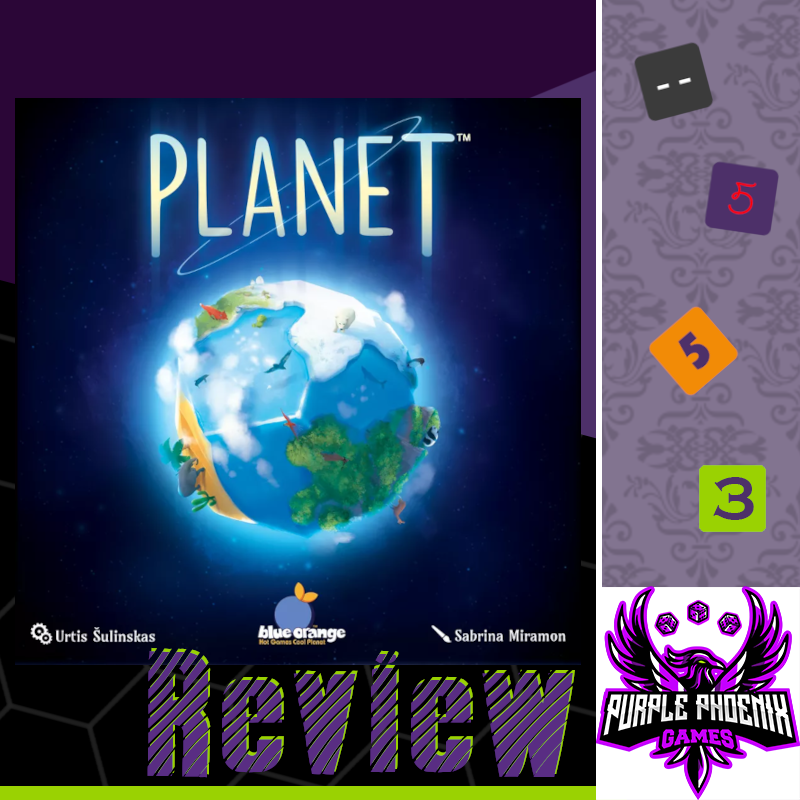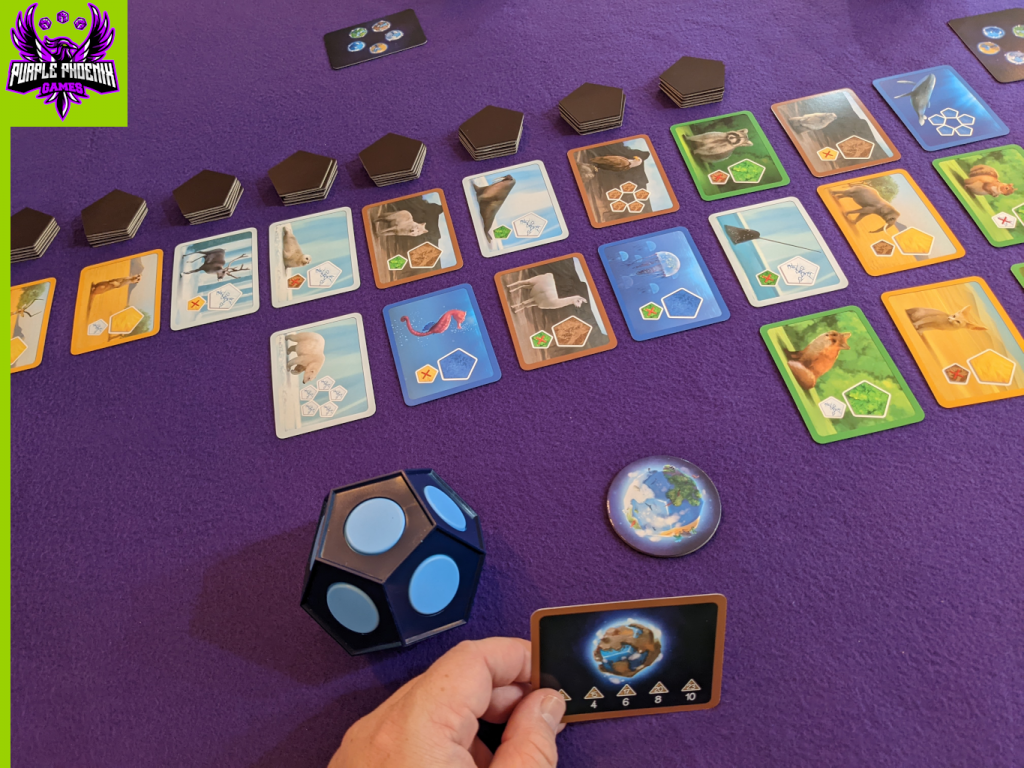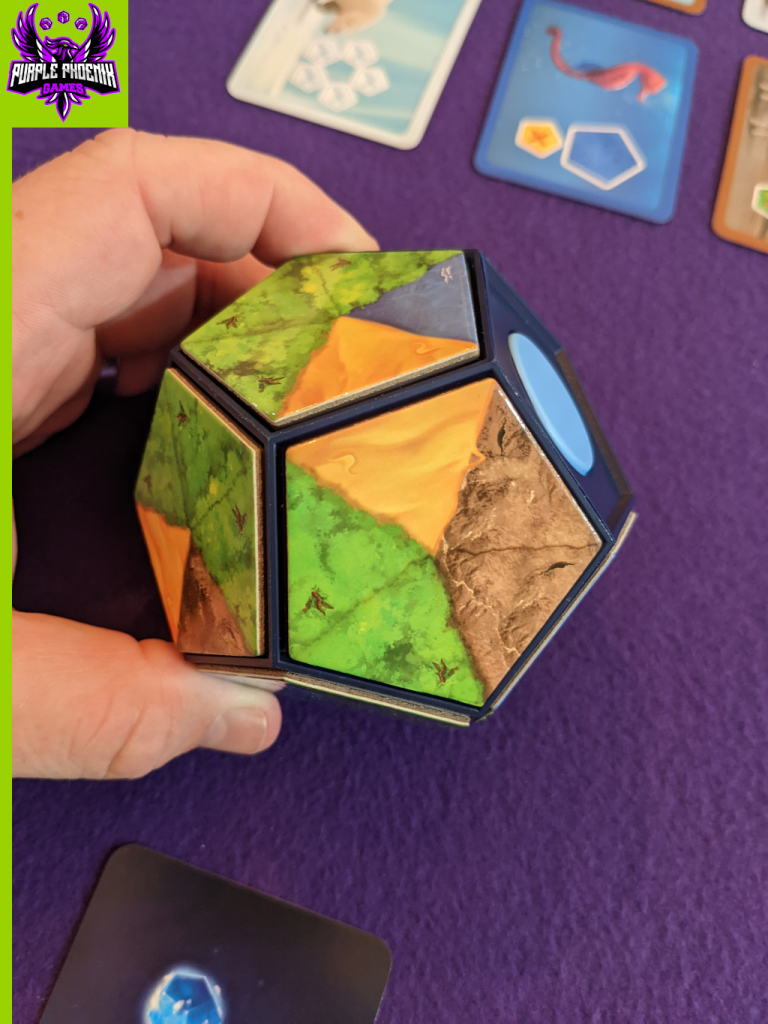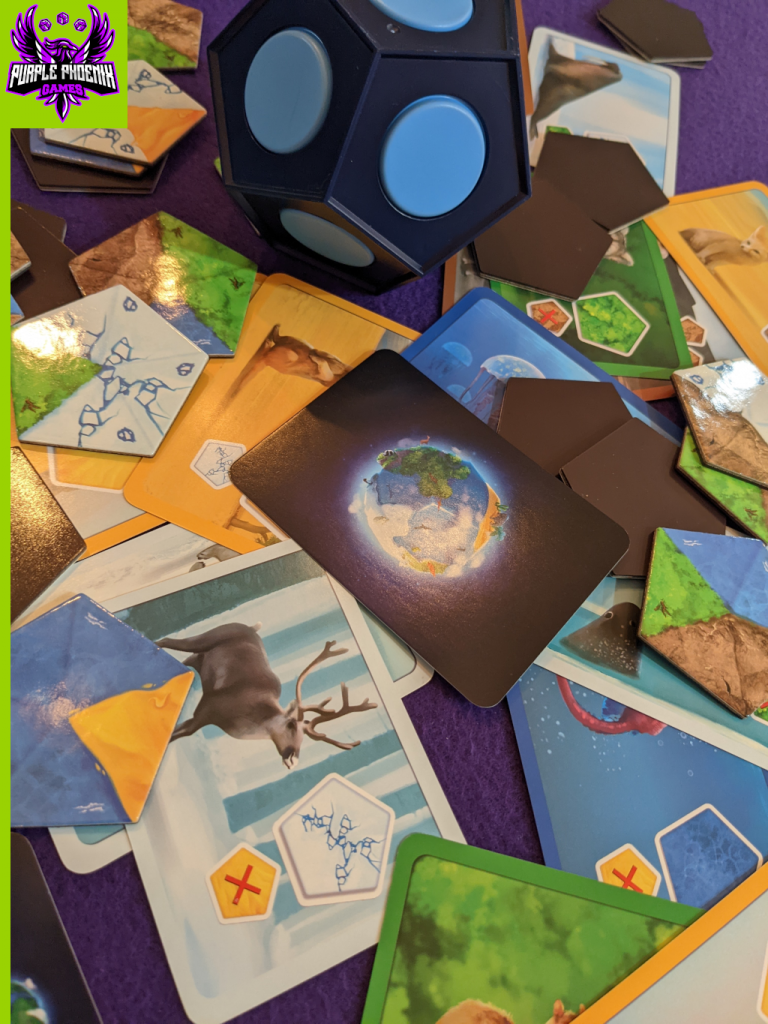
I have come to many conclusions as I age. One. I actually will NOT stay young and spry forever. Two. People definitely can change over time. Three. I would be okay at creating planets if creating planets was EXACTLY like playing the game Planet. As I unfortunately wasn’t around to witness the creation of planets, I’m not entirely sure how they were made, so I will just hop into my imagination copter and paint the story in my head as it unfolds on my table.
| Planet (2018) | Blue Orange Games |
| 2-4 Players | 30-45 minutes |
| Ages 8+ | BGG Weight – 1.58 / 5 |
Planet is an environmental, tile placement puzzle game with very unique components for two to four players. In it, players are creating 3-dimensional non-round globes that will also be inhabited by numerous animal species… if the players plan effectively. The winner of the game is the person who amasses the most points by creating the greatest planet at the table.
DISCLAIMER: We were provided a copy of this game for the purposes of this review. This is a retail copy of the game, so what you see in these photos is exactly what would be received in your box. I do not intend to cover every single rule included in the rulebook, but will describe the overall game flow and major rule set so that our readers may get a sense of how the game plays. For more in depth rules, you may purchase a copy online or from your FLGS. -T
To setup, each player takes a giant magnetic d12 from the box to act as their fledgling planet. Shuffle all magnetic Continent pentagonal tiles and create 10 face-down piles of five tiles each. These piles are placed in a line across the table. Shuffle all Animal Cards and add a row of 10 face-up cards underneath the third through twelfth pile of tiles. Yes, cards will be placed under ghost tiles for the eleventh and twelfth pile – they have yet to be built. A second row of Animal Cards will be spread under tile piles six through 12, and a third row of Cards under piles 10, 11, and 12 (setup shown in first photo below). The players each receive a unique Natural Habitat card featuring one of the five types of habitats as special objective scoring cards. The youngest player receives the 1st player marker and the game may begin!

Planet is played over 12 turns, and the first two turns are different from the final 10. Initially players will reveal the leftmost pile of Continent tiles, with the current 1st player drafting one such tile to add to their planet. Any undrafted tiles will be placed face-down above the cards for the eleventh round until they number five tiles in the pile. Subsequent undrafted tiles will then begin building the pile for the twelfth round, with any further tiles being discarded to the box. As tiles are drafted they are then added to the players’ planets in any place and direction they choose.
Starting with the third round, after tiles are chosen and added to each planet, the players then initiate The Origin of Life phase of the round where the Animal Card(s) beneath the pile are checked for scoring. Each Animal Card will feature a set of icons from three possibilities. The player will collect the card when they are determined to satisfy the conditions and will count toward their final score. These scoring conditions are: having the most of one kind of Region (multiple triangles of matching terrain), having the biggest Region of one kind which touches a specified Habitat (multiple triangles across multiple tiles where at least one triangle is adjacent to the secondary Habitat icon), and having the biggest Region which is NOT in contact with a specified Habitat (like the previous entry, but the Region canNOT be adjacent to the secondary Habitat icon). The player who best satisfies the round’s card(s) will collect the cards to be added to their scores.
At the end of the game, players will reveal their special objective cards that indicate bonus points for collecting the highest amounts of one Habitat type. Each Animal Card collected that matches this Habitat type is worth one point, and each Animal Card that is of any other Habitat type scores two points. Add up all the points and they who earned the most points is the winner!

Components. Okay, admittedly I am a sucker for a game with excellent components, even when I know said components are centered around a gimmick. But I just don’t care. These planet dice (different from Glass Cannon Podcast’s logo) are amazing! They feel absolutely premium quality and I have not had ANY issues with the planet cores nor the magnetic Continent tiles. The cards are all fine, feature cute animals and clear iconography, and serve their purpose well. It’s those planet cores that really do it for me. Each game I play I find myself just twirling it around in my hand and otherwise playing with it, spinning it on the table, or designing ways I can confiscate one to add to my Dungeons & Dragons dice set with proper 1-12 numerology for a proper d12. In any case, these components are excellent.
I alluded in the introduction that proper planning is essential for being successful with Planet. Each time I have played I am attempting to plan four or five turns ahead to set my planet up to maximize the scoring opportunities. Those that do not or cannot sadly do not fare well and rate the game poorly (see ratings graphic above). Planet is an interesting puzzle the entirety of the game and one that I relish scrutinizing. I do not believe I have ever played a game like it, or if I have I do not remember it feeling the same and having the same effect on my enjoyment.
I need to address the relationship between the animals on their cards and their favored terrain. I think that Planet mostly nails these, as I see Eagles preferring rocky terrain, Clown Fish preferring aquatic terrain far from any glacial temperatures, and Polar Bears preferring a vast amount of glacial terrain possible. All of this makes sense, and adds a bit of credibility to the game for being a proponent of environmental stability and sustainability without being at all political… which is very appreciated.
Laura and I were completely impressed with Planet, but our friend who played with us was not. In fact, their exact words about it were, “It’s good enough to be enjoyable a couple of times. But it didn’t super impress me.” Well, that friend is wrong. I can see myself enjoying this one for a great number of years, and I am looking forward to the day I can bust it out with my children and have them sit in awe of it. Purple Phoenix Games officially gives Planet a harshly-skewed 13 / 18, even though it would have scored 10 / 12 with just Laura and me. I thoroughly enjoy this one and would be happy to teach and play this as often as I could. If your preferences align with either Laura or myself, then treat yoself to a great game here. It seems readily available, or you may also pay me a visit and I would be glad to show it off to you. Just let me know before you show up to my door, thanks.

